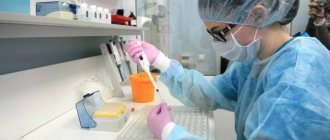What is ELISA?
Enzyme immunoassay in the clinic
Enzyme-linked immunosorbent assay (ELISA) is a laboratory test based on the high selectivity and specificity of immunological “antigen-antibody” reactions. The essence of the method is the identification of specific antibodies using special biochemical reactions that help determine the presence or absence of antibodies and their quantity. There are dozens of ELISA modifications. It is used to determine the presence of antigens of pathogens of various infections and to determine the presence of antibodies of classes (IgA IgM IgG) to antigens of various pathogens. Using the ELISA method, you can determine the level of hormones, immunoglobulins, immunological complexes and other biologically active substances, and determine antibodies to any sexually transmitted infection. The material for research can be blood, cerebrospinal fluid, vitreous contents, amniotic fluid, etc.
The basis of the enzyme immunoassay is the immune reaction of an antigen with an antibody, and the attachment of an enzyme label to the antibodies allows the result of the antigen-antibody reaction to be taken into account by the appearance of enzymatic activity or a change in its level.
What infections can be detected by ELISA?
ELISA is mainly used to diagnose syphilis (in combination with other reactions), HIV infection, and viral hepatitis. It is of limited value for the diagnosis of chlamydial infection, cytomegalovirus infection and other herpes infections. The ELISA method is also used to determine antibodies in various infectious diseases, hormone levels, autoantibodies and various markers of cancer.
Determining the presence and level of antibodies in the blood is not recommended for the primary diagnosis of sexually transmitted infections. The only exception is that based on the results of ELISA, it is possible to recognize syphilis in combination with a microprecipitation reaction. But the presence of antibodies in the blood serum can only indicate the body’s contact with the pathogen at a given time or earlier.
Studying the presence and level of antibodies of various classes in some cases helps to determine the stage of the infectious process.
Unfortunately, such an important advantage of ELISA as the quantitative determination of antibodies is not of great importance in practical work - i.e. does not allow an accurate diagnosis and does not affect the dosage and timing of medications.
Advantages of ELISA relative to other methods for detecting antigens and antibodies:
| - high sensitivity, which is 90%; | |
| — storage stability of all ingredients necessary for ELISA (a year or more); | |
| — speed and convenience of carrying out a diagnostic reaction; | |
| — the ability to use minimal volumes of test material; | |
| — the ability to automate all stages of the reaction; | |
| — low cost of diagnostic kits; | |
| — the possibility of early diagnosis of infection; | |
| — unification and suitability for mass surveys; | |
| — ease of tracking the dynamics of the development of an infectious disease process. |
The enzyme immunoassay method is used to determine the presence of antigens of pathogens of various infections and to determine the presence of antibodies of classes (IgA, IgM, IgG) to antigens of various pathogens (viral hepatitis, HIV, syphilis, TORCH, chlamydia, parasitosis). Using ELISA, you can determine antibodies to any infection, provided that the body has produced them. This method allows you to distinguish between acute and chronic forms of diseases, identify the stage of diseases and identify practically healthy carriers and control vaccination.
To make a diagnosis using the ELISA , laboratory tests are used to identify the pathogen, instrumental examination methods and clinical diagnostics. It must be taken into account that a reliable diagnosis of the disease cannot be made only by the presence of certain antibodies. It is necessary to simultaneously detect antibodies to the pathogen using ELISA and identify the pathogen using PCR or other methods.
DIAGNOSIS OF AUTOIMMUNE DISEASES
Antinuclear antibodies are autoantibodies to cell nuclear antigens. They form immune complexes and are deposited on the basement membranes of various tissues and organs, thereby causing inflammation and damage to tissues and blood vessels. The formation of such antibodies is characteristic of systemic autoimmune diseases. A test for antinuclear antibodies is carried out if the doctor suspects a systemic autoimmune disease.
Antibodies to double-stranded DNA are formed during systemic autoimmune lesions of connective tissue. These immune complexes are deposited on tissues and vessel walls and cause their damage. Antibodies to double-stranded DNA are specific for systemic lupus erythematosus.
Antibodies to soluble nuclear antigens (ENA screen) - screening test for antibodies to soluble nuclear antigens - (SSA(Ro), SSB(La), Sm, RNP, Jo1, Scl70). Formed in many systemic autoimmune diseases (systemic lupus erythematosus, Sjogren's syndrome, scleroderma, polymyositis, mixed connective tissue disease, rheumatoid arthritis). Positive test values are an argument that the patient has an autoimmune process and is an indication for differentiated determination of antibody titers to various ENAs for a more accurate diagnosis. For the differentiated determination of antibodies to soluble nuclear antigens, an enzyme-linked immunosorbent assay (combined ENA) is used.
Anticardiolipin antibodies IgG, IgM are autoantibodies to negatively charged or neutral phospholipids, phospholipid-binding serum proteins. Antibodies to phospholipids disrupt the normal functioning of the endothelium of blood vessels, causing vasoconstriction and the formation of vascular thrombi. An examination is prescribed if antiphospholipid syndrome is suspected (recurrent venous and/or arterial thrombosis).
Qualitative and semi-quantitative enzyme immunoassay determination of specific IgG antibodies to citrullinated peptide. The test system is intended for the diagnosis of rheumatoid arthritis of various stages, incl. the onset of the disease when clinical manifestations are mild. The effectiveness of the test for patients with clinically confirmed rheumatoid arthritis ranges from 78 to 88%.
Rheumatoid factor is found in rheumatoid arthritis, especially in the most common and common form of chronic joint inflammation called synovitis. 75-80% of patients with rheumatoid arthritis have rheumatoid factor, however, it is not specific to rheumatoid arthritis as it is found in healthy individuals and in a number of other diseases.
C reactive protein is a marker of the inflammatory process. The use of highly sensitive imported test systems makes it possible to detect C reactive protein not only in highly active inflammatory processes, but also in chronic and sluggish ones.
ANCA screen - determination of autoantibodies to cytoplasmic antigens of neutrophils (proteinase 3, myeloperoxidase). The analysis is prescribed if systemic vasculitis or glomerulonephritis is suspected.
All of the above studies are available in the Institute’s Clinical Immunogenetics Laboratory
All of the above tests and diagnostic methods are available to all patients, without exception, who contact the laboratory diagnostics department of the clinic.
Polymerase chain reaction (PCR)
PCR (polymerase chain reaction, PCR analysis) is a method of laboratory diagnosis of various viruses, bacteria, protozoa based on the detection of their genetic material (RNA and DNA) in the biological material being studied: in blood, saliva, ejaculate (sperm), urine, secretions from the genital tract, smears, scrapings, etc.
The PCR method is based on repeated doubling of a type-specific (i.e., characteristic of a particular microorganism) section of RNA or DNA, as a result of which a sufficient amount of RNA or DNA is produced for accurate identification of a given microorganism.
The PCR method is a molecular genetic research method.
Currently, polymerase chain reaction (PCR) is the most accurate and sensitive method for diagnosing latent infections (sexually transmitted infections) and other infectious diseases after culture testing (inoculation on the medium).
Thus, the results of a PCR study indicate the presence/absence of a direct infectious agent (viruses, bacteria, protozoa) in the organ under study (cell sample, tissue).
The main advantage of the PCR method is its high sensitivity and specificity, i.e. the ability to identify the causative agent of a disease if only a few molecules of its DNA or RNA are present in the sample. Therefore, it becomes possible to detect pathogens (including hidden infections) even in cases where their detection is not possible by other methods.
The specificity of PCR (i.e., the ability to accurately identify a given virus or bacterium) is close to 100%, which significantly exceeds the capabilities of microscopy and enzyme-linked immunosorbent assay (ELISA).
For this reason, PCR research has found wide application in the practice of doctors at the Women's Health Resort Clinic in the expert detection of hidden infections: chlamydia, mycoplasmosis, ureaplasmosis, trichomoniasis, bacterial vaginosis, human papillomaviruses and other sluggish or latent infections.
It should be taken into account that the result of a PCR study applies only to the organ (tissue) whose cellular material is taken for examination using a scraping smear.
This introduces certain limitations that in some cases do not allow us to judge the prevalence of the process. For example, detection of chlamydia in the cervical canal does not allow us to confirm the presence of chlamydia in the fallopian tubes, ovarian tissue, joints, lungs and other organs and tissues.
Thus, the PCR method (PCR analysis) is highly informative and reliable regarding infection (contamination) of a specific organ (tissue area), and the ELISA indirectly shows the prevalence of the process and the possible involvement of organs and tissues in the infectious process that are not available for direct diagnosis.
The ELISA and PCR methods complement each other. In the routine (everyday) practice of the Women's Health Resort Clinic, we use all research methods for quick, reliable diagnosis.
The collection of blood and smears for the purpose of conducting research using ELISA and PCR methods at the Women's Health Resort Clinic is carried out by professionally trained midwives who have undergone specialization in laboratory diagnostics. The collection of blood and smears is performed painlessly and in comfortable conditions.
Features of diagnosing sexually transmitted infections (latent infections) and conditions for preparing for research are described in detail on our website in the relevant articles.
- Genital herpes
- Gardnerellosis
- Candidiasis
- Mycoplasmosis, ureaplasmosis
- Human papillomavirus infection (HPV, warts, papillomas, condylomas)
- Trichomoniasis
- Chlamydia
- Appointment with a urologist to “get checked for EVERYTHING”
- Appointment with a gynecologist to “get checked for EVERYTHING”
- How to prepare for an appointment with a gynecologist?
We are at your complete disposal should you have any doubts or wishes.
We work seven days a week and on holidays:
Monday - Friday from 8.00 to 20.00, Saturday, Sunday, holidays from 8.00 to 17.00. Reception by appointment on multi-channel phone 8 (calls within Russia are free), or, or
Questions and answers
Question: ELISA analysis, what is it in gynecology? Answer: Enzyme-linked immunosorbent assay (ELISA) is a laboratory diagnostic method that involves identifying specific (individual for each microorganism, virus) antibodies. Based on the results of a blood test using the ELISA method, one can only indirectly (indirectly) judge the presence/absence of an infectious agent (viruses, bacteria, protozoa) by the response of the body’s immune (defense) system to it.
Question: How to detect chlamydia in the blood? Answer: Chlamydia in the blood can be detected by enzyme-linked immunosorbent assay (ELISA). Enzyme immunoassay allows you to determine antibodies of classes A, M, G to chlamydia in the blood. The sensitivity of detecting chlamydia by ELISA (method accuracy) is 50-60%. In other words, enzyme-linked immunosorbent assay (ELISA) allows you to determine the presence of antibodies (immunoglobulins (Ig) classes A, M, G) to chlamydia in the blood. Specific immunoglobulins of classes A, M, G are produced by the body in response to fresh (Ig A), recent (Ig M) appearance of chlamydia and long-term (Ig G) carriage of chlamydia .
Question: The PCR test is positive after treatment. How can this be? Answer: A positive PCR after treatment indicates the presence of DNA from the infectious agent: a virus or bacteria. Moreover, if the PCR smear was taken earlier than 30 days after the last dose of antibiotics, a positive PCR test may indicate the detection of dead bacteria or viruses. A positive PCR test after 30 days from the end of treatment indicates the persistence of the infection and the resistance of the infection to treatment, that is, the need to continue treatment.
Question: PCR analysis, what is it? Answer: PCR (polymerase chain reaction, PCR analysis) is a method of laboratory diagnosis of various viruses, bacteria, protozoa based on the detection of their genetic material (RNA and DNA) in the biological material being studied: in blood, saliva, ejaculate (sperm), urine , discharge from the genital tract, smears, scrapings, etc. The results of a PCR study indicate the presence/absence of a direct infectious agent (viruses, bacteria, protozoa) in the organ under study (cell sample, tissue).





